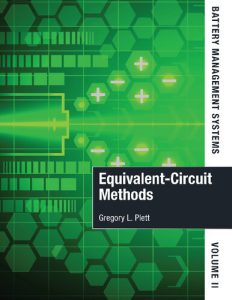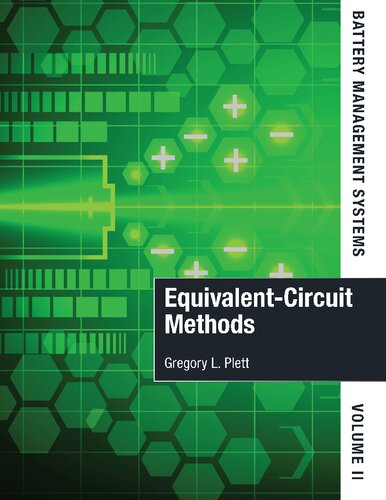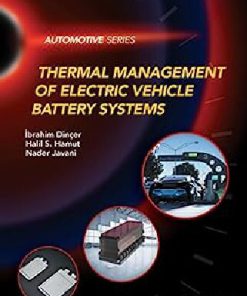Battery Management Systems Volume II Equivalent Circuit methods 2nd Edition by Gregory L Plett 9781630810283 1630810282
$50.00 Original price was: $50.00.$25.00Current price is: $25.00.
Battery Management Systems Volume II Equivalent Circuit methods 2nd Edition Gregory L Plett – Ebook PDF Instant Download/Delivery, ISBN: 9781630810283, 1630810282

Product details:
- ISBN 10:1630810282
- ISBN 13: 9781630810283
- Author: Gregory L Plett
Battery Management Systems, Volume II: Equivalent-Circuit Methods
Table contents:
1 Battery-Management-System Requirements
1.1 Battery-pack topology
1.2 BMS design requirements
1.3 Requirement 1a. Battery-pack sensing: Voltage
1.4 Requirement 1b. Battery-pack sensing: Temperature
1.5 Requirement 1c. Battery-pack sensing: Current
1.6 Requirement 1d: High-voltage contactor control
1.7 Requirement 1e. Isolation sensing
1.7.1 Potential isolation fault on negative side: Find R1
1.7.2 Potential isolation fault on positive side: Find R2
1.8 Requirement 1f. Thermal control
1.9 Requirement 2. Protection
1.10 Requirement 3a. Charger control
1.11 Requirement 3b. Communication via CAN bus
1.12 Requirement 3c. Log book function
1.13 Requirement 4a. State of charge estimation
1.13.1 What needs to be estimated and why?
1.13.2 What really is state of charge (SOC)?
1.14 Requirement 4b. Energy estimation
1.14.1 Cell total energy estimation
1.14.2 Battery-pack total energy estimation
1.15 Requirement 4c. Power estimation
1.15.1 Cell power estimation
1.15.2 Battery-pack power estimation
1.16 Requirement 5. Diagnostics
1.17 Where to from here?
2 Simulating Battery Packs
2.1 Modeling battery cells
2.2 Modeling approach 1: Empirical
2.3 Modeling approach 2: Physics-based
2.4 Simulating an EV
2.5 Equations for vehicle dynamics
2.6 EV simulation code
2.6.1 setupSimVehicle.m
2.6.2 simVehicle.m
2.7 EV simulation results
2.8 Simulating constant power and voltage
2.9 Simulating battery packs
2.9.1 Series-connected cells
2.9.2 Packs comprising parallel-connected cell modules
2.9.3 Packs comprising series-connected cell modules
2.10 PCM simulation code
2.11 Example PCM results
2.12 SCM simulation code
2.13 Example SCM results
2.14 Where to from here?
3 Battery-State Estimation
3.1 SOC estimation
3.2 A careful definition of state of charge
3.3 Some approaches to estimate SOC
3.3.1 Poor, voltage-based methods to estimate SOC
3.3.2 Poor, current-based method to estimate SOC
3.3.3 Model-based state estimation
3.3.4 Sequential probabilistic inference
3.4 Review of random processes
3.4.1 Random variables
3.4.2 Vector RVs
3.4.3 Properties of jointly distributed RVs
3.4.4 Vector random (stochastic) processes
3.5 Sequential probabilistic inference
3.5.1 The six-step process
3.6 The linear Kalman filter
3.6.1 Deriving the linear Kalman filter
3.6.2 Visualizing the linear Kalman filter
3.6.3 MATLAB code for the linear Kalman filter steps
3.6.4 Improving numeric robustness
3.7 The extended Kalman filter
3.7.1 Deriving the six steps of extended Kalman filter
3.7.2 An EKF example, with code
3.8 Implementing an EKF using the ESC cell model
3.8.1 Computing the EKF matrices
3.8.2 A refactored implementation of the EKF
3.8.3 Example of EKF on ESC model
3.9 Problems with EKF, improved with sigma-point methods
3.9.1 Approximating statistics with sigma points
3.10 The SPKF
3.10.1 Deriving the six steps of SPKF
3.10.2 An SPKF example, with code
3.11 Implementing SPKF using the ESC cell model
3.12 Real-world issues pertaining to sensors, initialization
3.12.1 Current-sensor bias
3.12.2 Voltage-sensor faults
3.12.3 Other sensor faults
3.12.4 Initialization
3.13 Reduced computational complexity using bar-delta filtering
3.13.1 Bar-delta filtering using the ESC cell model: The bar filter
3.13.2 Bar-delta filtering using the ESC cell model: The cell delta filters
3.13.3 Example of bar-delta filtering, using desktop validation
3.13.4 Examples of bar-delta accuracy and speed
3.14 Where to from here?
3.15 Appendices: Algorithms for state estimation
4 Battery Health Estimation
4.1 Need for health estimates
4.1.1 Total capacity
4.1.2 Equivalent series resistance (ESR)
4.1.3 Other cell parameters
4.2 Negative-electrode aging
4.2.1 Negative electrode aging at surface of particles
4.2.2 Negative electrode aging in bulk
4.2.3 Negative electrode aging in composite electrode
4.3 Positive-electrode aging
4.3.1 Positive electrode aging at surface of particles
4.3.2 Positive electrode aging in bulk
4.3.3 Positive electrode aging in the composite electrode
4.4 Sensitivity of voltage to R0
4.5 Code to estimate R0
4.6 Sensitivity of voltage to total capacity Q
4.7 Estimating parameters via Kalman filters
4.7.1 A generic approach to parameter estimation
4.8 EKF parameter estimation
4.9 SPKF parameter estimation
4.10 Joint and dual estimation
4.10.1 Generic joint estimation
4.10.2 Generic dual estimation
4.10.3 Joint state and parameter estimation via EKF
4.10.4 Dual state and parameter estimation via EKF
4.10.5 Joint state and parameter estimation via SPKF
4.10.6 Dual state and parameter estimation via SPKF
4.11 Robustness and speed
4.11.1 Ensuring correct convergence
4.12 Unbiased estimate of total capacity using linear regression
4.12.1 The problem with least-squares capacity estimates
4.13 Weighted ordinary least squares
4.14 Weighted total least squares
4.15 Goodness of model fit
4.16 Confidence intervals
4.17 Simplified total least squares
4.17.1 TLS with proportional confidence on xi and yi
4.18 Approximate full solution
4.18.1 Deriving the approximate weighted total-least-squares cost function
4.18.2 Minimizing the AWTLS cost function
4.18.3 Solving the quartic equation
4.18.4 Summary of approximate weighted total least squares
4.19 Code to simulate the methods
4.20 Example HEV simulations
4.20.1 HEV application, scenario 1
4.20.2 HEV application, scenario 2
4.20.3 HEV application, scenario 3
4.21 Example EV simulations
4.21.1 EV application, scenario 1
4.21.2 EV application, scenario 2
4.21.3 EV application, scenario 3
4.22 Discussion of simulations
4.23 Where to from here?
4.24 Appendices: Nonlinear Kalman-filter algorithms
5 Cell Balancing
5.1 Causes of imbalance
5.2 Not causes of imbalance
5.3 Balancer design choices
5.3.1 What balance setpoint?
5.3.2 When to balance?
5.3.3 How to balance?
5.4 Circuits for balancing
5.4.1 Dissipative: Fixed shunt resistor
5.4.2 Dissipative: Switched shunt resistor
5.4.3 Nondissipative: Multiple switched capacitors
5.4.4 Nondissipative: One switched capacitor
5.4.5 Nondissipative: Switched transformer
5.4.6 Nondissipative: Shared transformer
5.4.7 Nondissipative: Shared bus
5.5 How quickly must I balance?
5.6 Balancing simulation results
5.7 Where to from here?
6 Voltage-Based Power-Limit Estimation
6.1 Traditional, terminal-voltage-based power limits
6.2 Voltage-based power limits, using a simple cell model
6.2.1 Rate limits based on SOC, maximum current, and power
6.3 Voltage-based power limits, using a full cell model
6.4 Bisection search
6.5 Where to from here?
7 Physics-Based Optimal Controls
7.1 Minimizing degradation
7.1.1 Modeling cell degradation
7.2 SEI formation and growth
7.2.1 Full-order model (FOM)
7.2.2 Simplifying the model
7.2.3 Simplifying the calculation
7.3 SEI ROM results
7.4 Lithium plating on overcharge
7.4.1 Physics-based model of overcharge
7.5 Plating ROM results
7.6 Optimized power limits
7.7 Plug-in charging
7.8 Fast-charge example
7.9 Dynamic power calculation
7.10 Where to from here?
People also search:
battery management systems volume ii equivalent circuit
battery management systems volume ii equivalent-circuit methods
battery management systems volume ii equivalent-circuit methods pdf
battery management systems volume i battery modeling
battery management systems volume i battery modeling pdf
You may also like…
Engineering - Electrical & Electronic Engineering
Logic Circuit Design Selected Topics and Methods 2nd Shimon P. Vingron
Business & Economics - Project Management
Methods of IT Project Management, 4th Edition Jeffrey L. Brewer
Computers - Databases
Multivariate Reduced-Rank Regression: Theory, Methods and Applications 2nd Edition Gregory C Reinsel
Engineering - Environmental
Water Management in the Era of Climatic Change: Volume II 2nd Edition Alban Kuriqi
Technique - Energy: Renewable Energy
Battery Management System and its Applications 1st Edition Xiaojun Tan
Uncategorized












